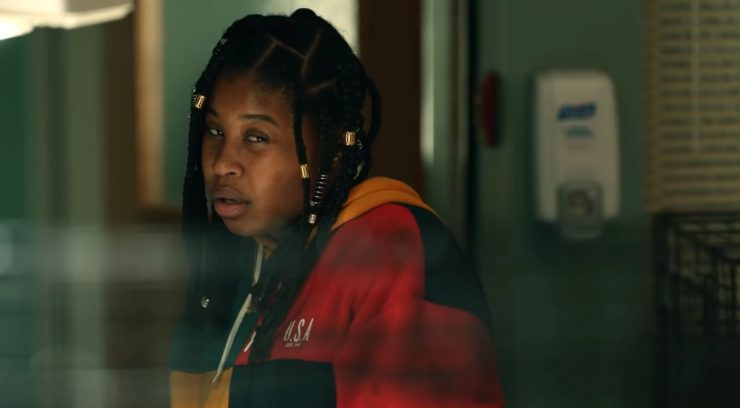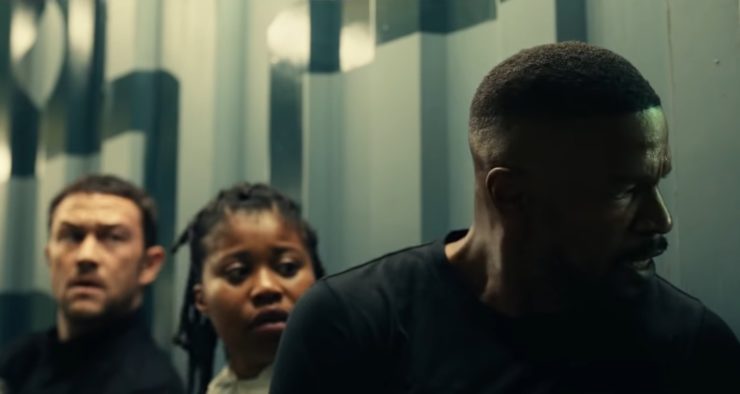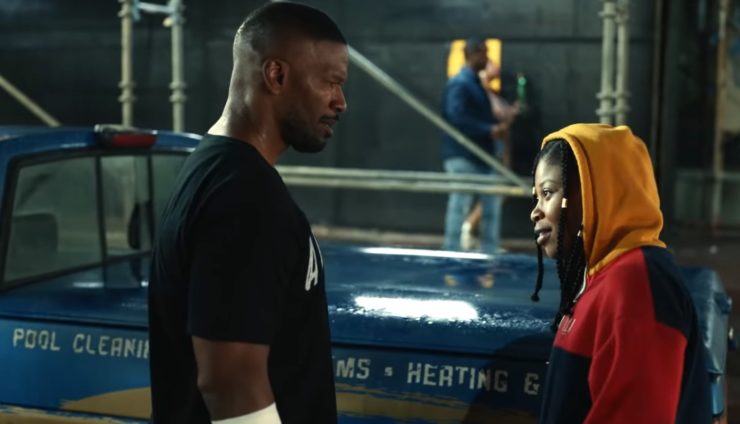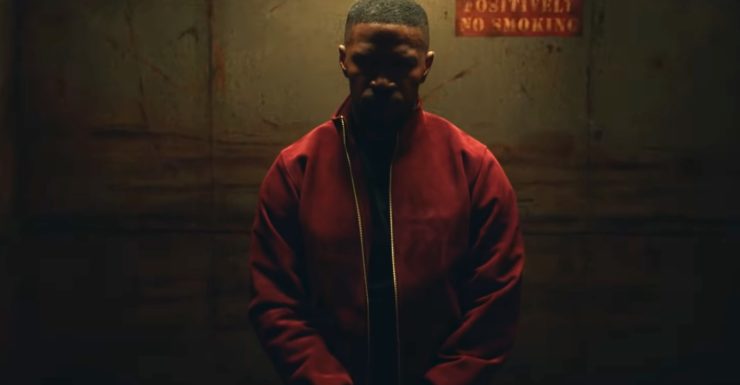There are plenty of superhero narratives that discuss the possibility of medical experimentation as an origin plot. A hefty portion of Marvel Comics’ roster have powers as a result of various “super soldier” projects that first proved successful with Steve Rogers. But there’s a pointed difference with the origin of Captain America, and his transformation from literal small fry to a man capable of throwing motorcycles and halting helicopters on their launch pads:
He signed up for this.
[Some spoilers for Project Power.]
The truth of medical experimentation throughout human history is a far uglier enterprise, one bound up in racism, sexism, and dehumanization. In particular, the medical establishment has a time-honored tradition using the bodies of women of color as testing ground for anything they might eventually want to bring to the masses. (Just take a peek at the history of birth control, if you ever want a devastating crash course in this practice.)
And while there are a few superhero stories on screen that haven’t shied away from the issue of medical experimentation (Deadpool being perhaps the most prominent example), none have tackled the idea with such an eye toward truth as Project Power.

Art (Jamie Foxx)—otherwise known as “The Major”—was one of the first test subjects used to create a new street drug called Power, which can give the user superpowers for five whole minutes. (What power you get is down to the individual, which means that there’s a chance the user could… well, explode.) Art was involved in the military study for Power when his daughter was born, which means that she was somehow born with inherent abilities, leading to her capture by the group making the drug. He is desperate to find her, and ends up kidnapping Robin Reilly (Dominique Fishback)—a local student who is also a drug dealer for Power, trying to earn enough money to get her mother the expensive medical treatments she needs to live. The third member of their unlikely trio is a New Orleans cop named Frank Shaver (Joseph Gordon-Levitt) who has been buying Power off of Robin to make himself bulletproof and do some good in their city.
New Orleans is the other star of the film, and Project Power means to show viewers what happens when the world decides to forget a place because its denizens aren’t deemed camera-worthy enough to help. While refusing to glorify the police and the power they wield, Frank is still a character struggling with a familiar point of superhero angst—he wants to help a city that the world is keen to ignore. When suited goons keep showing up to interfere in police jurisdiction every time Power is involved, Frank talks to his police chief about what happened the last time “men in suits” got involved in their city’s affairs. This reminder of the damage done by Hurricane Katrina fifteen years ago, damage that is still waiting on relief that will never come, is central to the powered dynamics that the film focuses on.

The fact that the drug is called Power is no accident; while the term “superpowers” has become common enough in our vernacular, its prevalence helps us to conveniently gloss over the concept of power alone and who gets to have it—something that superhero stories are primed to address. Art talks to Robin about her choice to be a drug dealer, and while he starts off unforgiving of her choices, he later encourages her to find her own form of power and own it. Art and Robin are both all too aware that the system they live in is designed to use up and toss aside Black people, and are both desperate to be free of that system, for themselves but primarily for the people they love. Frank’s ability to be a secondary protagonist in this film comes from his understanding of the system, and the fact that he commits to helping both Art and Robin with whatever power he has at his disposal.
It’s important to note another side to this film’s success: There has been a gap in cinema for at least a decade now, with the mega-blockbusters pushing out all the smaller, sharper, often more interesting action films audiences used to be able to expect alongside the tentpoles. Things that didn’t come with franchises attached and the need to build elaborate mythologies in their wake. While it’s unfortunate that these films are now being relegated to televised releases instead of theatrical ones—this movie would have been incredible in a theater—it’s heartening to see stories like this finding new ways to get made and new venues to appear in.

Project Power is shot with an immediacy that is captivating, often with the quality of hand-held cameras absent the shakiness that can make a viewer nauseous. Its action sequences are frequently filmed from odd vantage points, highlighting how quickly power can change hands. The special effects are impressive for the movie’s under-one-hundred-million dollar budget, and the casting is superb: Fishback in particular is one to look out for, playing Robin with such an ease and humor that you immediately adore her. Foxx and Gordon-Levitt are both old hat at this sort of thing, but they lend the film all the gravitas that it requires. Also be on the lookout for Andrene Ward-Hammond’s turn as Irene, Robin’s mother, who gets the opportunity to be both warm and hilarious in the role.
But the crux of the film’s plot is the search for Tracy (Kyanna Simone Simpson), Art’s daughter, who has been held hostage by the people developing Power so that they can further study and experiment on her. At the head of this group of lackeys is a woman known only as Gardner (Amy Landecker), who tells Art that this is for the best, that his daughter is the new Henrietta Lacks: destined to progress modern medicine and science beyond its wildest imagination. Lacks is another Black woman in medical history whose body was used without her consent—while being treated for cancer, two samples were taken from her cervix without her knowledge and used to produce the HeLa cell line. The fact that Gardner can so casually disregard Tracy’s autonomy—and humanity—to her own father is central to the film’s through line in regard to superhuman abilities. Project Power knows that the people who would pay the price for a future full of super soldiers were never people like Steve Rogers, or even Bruce Banner. They’re people like Tracy and her father.

My only (minor) beef with the film is lack of focus on Tracy herself. While what we see of her is beautiful, the fact that we don’t get to appreciate this story from her perspective seems like a missed opportunity. The love she has for her father, the hope of escaping her captors, the fast rapport she develops with Robin, all of these things deserved more breathing room in the script. If the film happens to get a sequel—they don’t set it up, but the story is rife with material for one—my hope is that it would center on her. Yet even without that followup, Project Power has so much to offer its audience—about power, about agency, and about carving out the paths to freedom that people deserve.
Emmet Asher-Perrin would also watch an entire movie about Robin’s rap career, which was easily a highlight of the film. You can bug them on Twitter, and read more of their work here and elsewhere.










